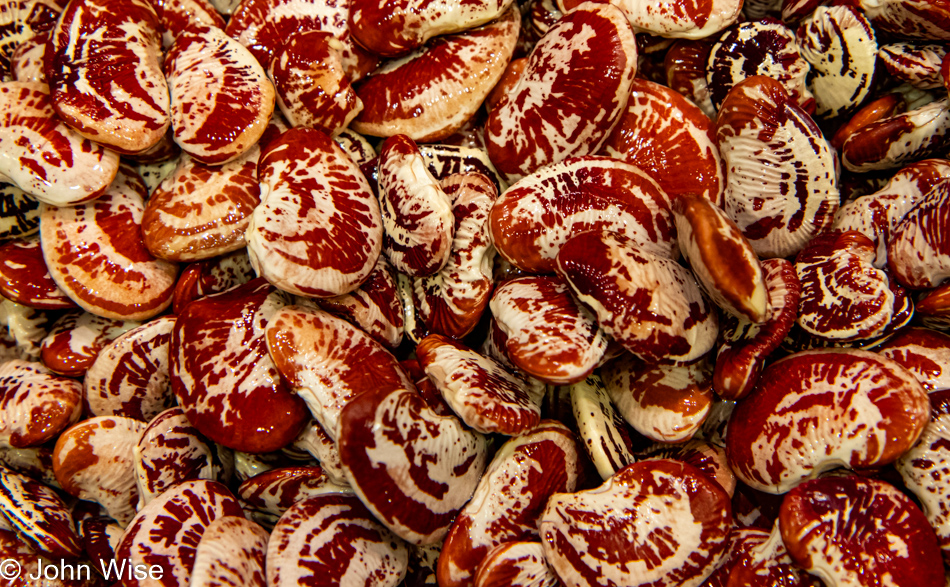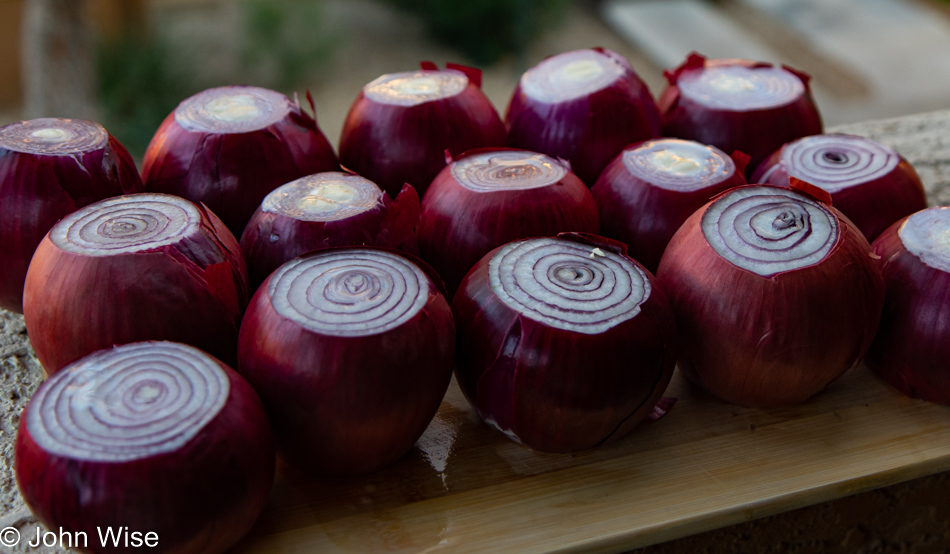
I see the moment coming when I have little more to say about what will become routine here in Frankfurt. I’m yet to visit the west side of the city or test how far I can walk along the Main River before I’ll want to catch a train back, so there are options. There are also pending dates with family and friends on the calendar and visits to cities well outside of Frankfurt, but I need to get a few nights of proper sleep so I can wake up at 5:00 a.m. or so in order to get an early start. Then there’s the weather to contend with because if there’s a downpour, there is nowhere to dip into other than underground train stations, but those are not always nearby.
Regarding the weather, this is the one obstacle I’m not really prepared to contend with. Sure, I have my rain jacket and an umbrella, but if I decide to stay in, I have very little to entertain me. I do not have unlimited bandwidth, nor do I even have a kitchen. The forecast shows rain and thunderstorms for the next five days, and I’m paying attention to travel restrictions within the EU. As of early June, a visit to France may not be in the cards. Speaking of weather, places to go, and things to do, I need to get out before the rain starts again.
Finding bakeries are offering tables outside again so that we can sit down and enjoy breakfast is a welcome relief. The tables and chairs had been stacked and locked with cables running through them, letting people know that they were not welcome to sit there, and so that’s just what I’m doing this morning. Not having to grab something to go and eating it underway is far more civilized in addition to allowing me to spend another small part of the day not trapped inside an apartment.

This brings me to the question I hear a lot, “Why isn’t Caroline with you?” This is not a vacation, and as much as I was hoping prior to leaving the United States that I could carve out some of that, it just isn’t possible yet. Vacations are times when we move away from routines to assume temporary new ones while we are out traveling. The key, though, is that we are allowed a broad amount of spontaneity, spontaneity that is difficult to come by during a pandemic, as enforced in Germany at least. Some of the inconveniences look awkward to me, such as waiting in line to enter a department or electronics store or maybe even having to make an appointment first. I hope I don’t need an article of clothing or a USB cable while I’m here.
In the last few days, museums started opening for those willing to make a reservation first, and while this is possible due to falling infection numbers, they are going up in Frankfurt again, which could bring new restrictions. How does one vacation under these conditions? So, Caroline is at home, and it is looking less and less likely that maybe I could bring her over before the end of June. When Europe opens for travel, it will be for the people of Europe first, and those travelers will have to provide proof of their vaccination or having had COVID. America is nowhere close to offering our citizens certification of proof. This means that while Europe may want U.S. tourists to return, they will have to resolve the issue of our belligerence regarding the issuing of certification that meets any security requirements against forgery. On the other hand, my CDC card has been accepted everywhere without much friction at all.
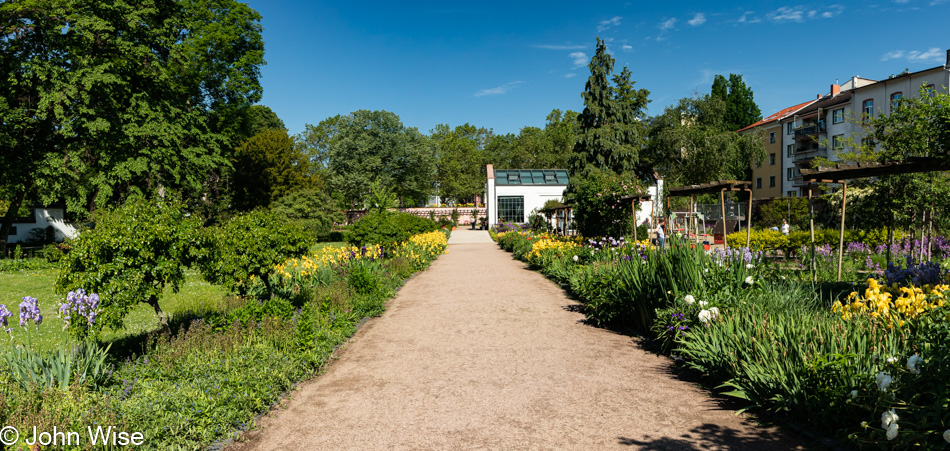
There’s nothing like the arrogance of youth and the angst that comes with it to blind a person to the importance of being present in their space and not just their head. I lived in Frankfurt and the surrounding area for ten years and somehow, I missed that the former wall that surrounded the city here had mostly been turned into parks and green areas. Back then, I could have been reading in a cave and been as happy and aware of what was around me as a hermit who spent his life under a bridge.

Now, here I am in the later stages of life, and I kick myself for not being more aware of my surroundings, but maybe I’m fooling myself, and the necessary awareness was there while the mind needed more attention due to neglect suffered early on, inflicted by those who didn’t themselves possess the intelligence to know how to guide a child. Flowers, in this regard, are lucky; they pass on genetics, pollinating insects are naturally drawn to their vibrance, and the human eye takes delight. We, on the other hand, are difficult and messy; we are certainly not flowers in any sense of the idea.
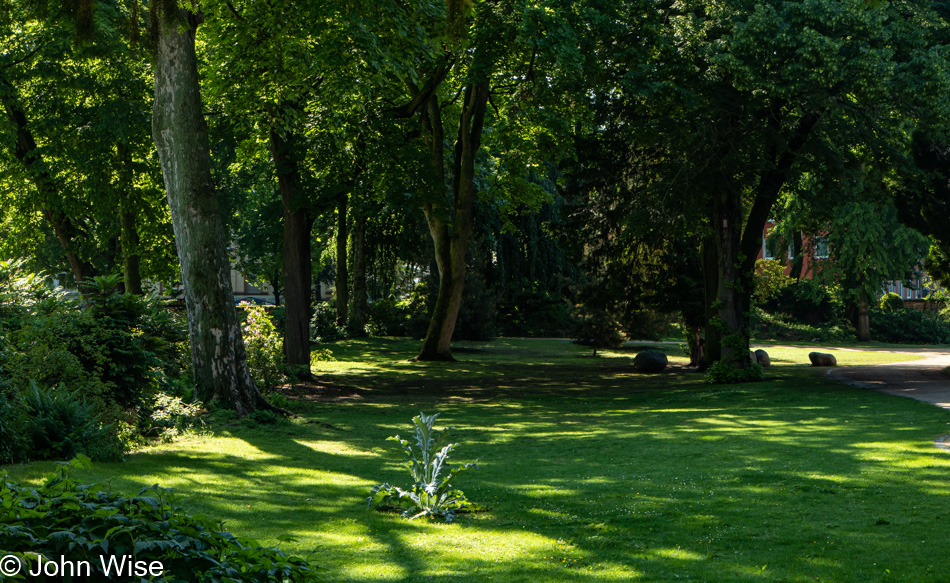
No matter what we build, will people ever construct a building that can cast shadows as beautiful as this display in the park as the sun spills through the leaves? I do admit that stained glass can have an equally appealing nature, but that’s the exception until I find something else to contradict me.

I’ve been walking through Bethmann Park, part of which is a Chinese Garden, and I already might have to change my mind about human construction, as light traveling through a pagoda does hold a lot of intrigue.

It was just a few days ago that Caroline was serenading me with a ukulele and her sweet voice from so many thousands of miles away with her own rendition of “You Are My Sunshine, My Only Sunshine.” Seeing this put a smile on my face as it felt nicely serendipitous.

Masks, baseball caps, hijabs, branded clothing, makeup, hairstyles, types of clothing, and preferred methods of travel are all masks for the masses. The only difference is which cultural hegemon is dictating what will be stylistically acceptable. Here in Europe, there’s no small uproar regarding Islamic headdresses for women. Some in the West look at it as oppression of women’s free will, and yet when a major bank or corporation dictates that their workers conform to particular styles of uniform, be it shirt and tie or a smock, we’ve deluded ourselves into believing that this is still freedom. Cultural style is fluid; if it weren’t the average peasant would own a single pair of clothes, only the wealthy would be the only ones allowed to wear purple, and strict rules would govern how much hair is to be seen. When we pander to the angry who don’t like what they see, we empower them to ask for more intolerance.
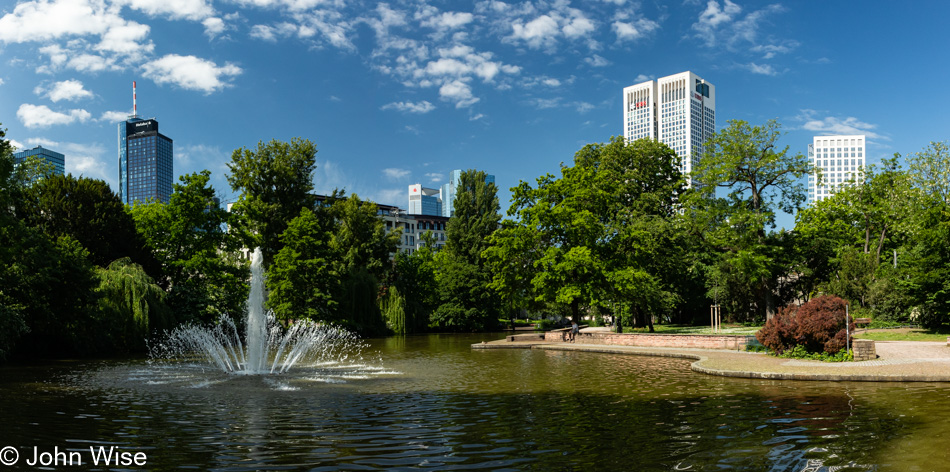
It’s now two minutes past the time that severe thunderstorms were supposed to arrive. I’ll blame their delay on the train service because Deutsche Bahn is probably behind everything that’s broken here in Germany. What’s not broken though, at least from my view, are the plentiful green areas. There’s a serious need for housing in Frankfurt, and yet the green areas have not been sold off to build another billion Euros worth of highrise apartments and shopping. There are areas such as Gallusviertel that have been dramatically renovated due to reclaimed land previously used by the freight train system, and while I’ve not been over there to explore it, I’d wager that quiet green spaces have been included in order to improve the quality of life.
This is in comparison to where I live in Phoenix, Arizona. In the desert, our money-grubbing money lords only see green when it is available in the form of cash. Every bit of desert that can be covered with profit is used. If you want nature, you have your car to jump into and go find it somewhere else. Our neighborhoods are dead zones not meant to be livable unless you consider staying in your backyard and not being able to walk anywhere else, living. Tourism is not happening right now in Germany, and yet the streets are full of people walking around at 11:00 in the morning, seemingly just meandering. There’s time to stop and look at fountains, smell the flowers, or have a beer at a nearby park bench.
My eye is on the sky, looking for the approach of dark clouds so I can make my way over to the Historical Museum of Frankfurt, but I think my stomach is starting to hint at having an early lunch. Meanwhile, my brain is asking, what’s wrong with sitting right here next to the fountain at Bockenheimer Anlage? I’ll tell you what’s wrong: I’m still an American and haven’t deconditioned myself yet to accept that I can just sit here doing next to nothing. I say next to nothing because here I am with my laptop in said lap, and I’m writing, though, at the same time, I’ve been watching a family of swans traverse the pond while nearby birds sing to me. I think my stomach will win this one.

Even at midnight, I don’t believe I’ve ever seen the Alte Oper (Old Opera) with so few people here. If you look at many of the photos I’ve already shot on this journey through the pandemic in Germany, you might notice how deserted everything feels.

This is the Paulskirche (St. Paul’s Church). It played host to the 1848 legislative body, which was the first time in German history that government leaders were freely elected.

I have a bad feeling about my choice for lunch here at Haus Wertheym at Romer, but I’m just around the corner from Jutta’s, and so if rain arrives during my meal, I’ll have but a short walk to get out of the potential downpour. I’m having five different sausages on sauerkraut with Bratkartoffeln. I’m also next to the Historical Museum which is open until 6:00, so maybe I’ll make it in there today. Eating out three times a day is becoming tiresome.
Lunch was quite okay while the humidity was becoming oppressive. I’m overhearing conservations about how restaurants will open their dining rooms to those with vaccines or current COVID tests and that outside seating will be open to all this coming Monday. Yet another iteration of normal is on its way.

Another day, another photo of Jutta. That’s the face of someone happy to have just been the recipient of hugs.

The rain started falling, and those earlier forecasts of severe thunderstorms had me on guard, so now was the time to visit the Historical Museum of Frankfurt.

Caroline saw this as I populated this post with photos; she made a few guesses but was wrong about its exact purpose, though she knew what its relative purpose was. So, to correct her, it is not a butthole dilator. But that’s close: it was used for helping a pregnant woman dilate the birth canal while in labor. To be honest, I don’t know why these aren’t sold at sex shops for hanky panky.

The father of a young Wolfgang Amadeus Mozart effectively scratched into the window where he and his children were staying in Frankfurt, “Mozart slept here.” If you think this is hard to see, you should have tried finding it among the eight panes of glass that make up the window that was saved. Leopold Mozart carved this using a diamond ring back on 12 August 1763.

There’s no denying among the intelligent that a holocaust happened here in Germany and the surrounding countries that the Nazis occupied. The attempted mass extinction of Jews was the primary aggression, but many, many others were being swept up for the cause of slavery and the “cleansing” of society. A dark chapter for sure, but one I’m happy to see Germany putting on display to acknowledge the savagery.

The Allied bombing of Frankfurt destroyed much of the city; the ensuing fires destroyed even more. One family donated to the Historical Museum a lump of glass that was once their dishes which melted in their cupboard during one such firestorm. Strangely enough, a teacup and sugar bowl remained intact, though locked in what remains of their dishes.

Zyklon B, the notorious “Gift” gas used to kill 100’s of thousands if not millions. “Gift” in German is poison, so there’s no cheeky nonsense from me regarding what this was. It was death in a can, and it came from right here in Frankfurt. The name of the company that made this product was Degesch, part of the industrial conglomerate known as I.G. Farben.

This soldier is celebrating Victory in Europe Day on the 8th of May 1945 in front of the I.G. Farben headquarters building. At the end of the war, it became the Command Headquarters of U.S. Forces Europe for the duration of the occupation

This guy stood outside some building on Kaiserstrasse, and if it weren’t for all the time I spent in the redlight district of Frankfurt in front of the Hauptbahnhof, I may have never seen him

I’ll likely be heading back to the Historical Museum of Frankfurt as there’s much to see, and a few hours wasn’t enough to truly see the 2nd and 3rd floor of the new part of the museum, and consequently, I didn’t get to visit the older side of the museum.

The stack of books in the back of the photo represents the German National Library, and the five books standing up is the old I.G. Farben building, now a branch of Goethe University.

I wasn’t a graffiti artist before I left Germany in 1995, but today, I leave my mark on Frankfurt.

Is this the sign that the dreaded severe storm of the century is approaching?

This photo is only here because it represents a distant part of our past from a club we used to visit called the Batschkapp. In front of that club was a smaller bar and music venue. Elfer Club is now located in Sachsenhausen and even if it were open, there’s no chance we’ll ever see a need to visit, but isn’t that the nature of memories that are better left behind us?

In my ongoing journey into Grüne Sosse and Handkäse mit Musik, Caroline directed me down a series of small streets to some places popular with the apple wine crowd, which automatically suggests traditional Frankfurt food. The first place I came to was Frau Rauscher and they made space for me. Five German lads sitting near the entry acted as the welcoming committee and spent about 15 minutes talking with me. While they played their dice game we talked about what brought me here and life during the pandemic.

This is the spitting Frau Rauscher, which Caroline should tell you more about as she asked that I be sure and snap a photo of her, so here’s her contribution: “Rauscher” is the name for apple cider as it is in the process of fermenting into apple wine. Frau Rauscher refers to a legendary drunk female who was known for stealing punters’ drinks and, when challenged, would spit the drink back into people’s faces instead of returning the glass. A popular ballad in the local dialect describes how one day, she was seen with a big bump on her head, and police were called to figure out whether she had knocked her head while drunk or whether her husband had hit her. The fountain was erected in 1961.
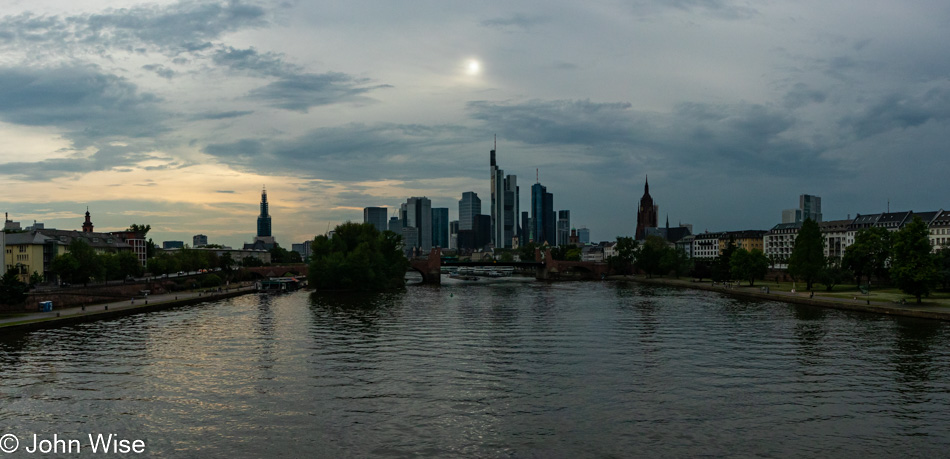
I could have a dozen photos of Frankfurt’s skyline before I leave Germany, and I don’t think I’d ever grow tired of enjoying it.

This monument to Caroline and I has been here for a number of years, but who wants to brag that they’ve had a monument built for them in their lifetimes? Yeah, Frankfurt loves us, and we love Frankfurt.



